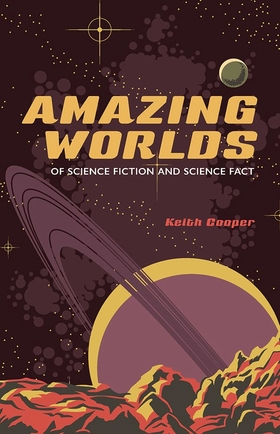Centauri Dreams
Imagining and Planning Interstellar Exploration
Throttling Up Ion Thruster Technologies
Although I want to start the week by looking at hybrid propulsion technologies, let’s start by considering developments in ion propulsion before going on to see how they can be adapted for future deep space missions. Hall thrusters are a type of ion engine that uses electric and magnetic fields to manipulate inert gas propellants like xenon. The electric field turns the propellant into a charged plasma which is then accelerated by means of a magnetic field [see reader ‘Supernaut’s correction to this in the comments below].
We’ve seen the benefits of ion engines in missions like Dawn, which has recently received a second mission extension to continue its work around the asteroid Ceres. Now we learn that a Hall thruster called X3, developed at the University of Michigan by Alec Gallimore, has received continuing design modification by researchers at NASA Glenn and the US Air Force, scaling up the low thrust levels produced by conventional ion engines. A series of tests have demonstrated results that have implications for future manned space missions.
In fact, the X3 breaks all previous Hall thruster records, producing 5.4 newtons of force compared with the earlier 3.3 newtons. As noted in this University of Michigan news release, the X3 design also doubles the operating current record, reaching 250 amperes vs. 112 amperes, while running at slightly higher power levels than previous designs. A Hall thruster with higher power and improved thrust levels could shorten travel times, a significant factor as we work to mitigate radiation problems for human crews on long interplanetary missions.
At Glenn Research Center, doctoral student Scott Hall (University of Michigan) worked with NASA’s Hani Kamhawi on experiments to test the improved thruster, using the only vacuum chamber in the United States large enough to cope with the X3’s exhaust, even though the sheer amount of xenon can still cause some of it to drift back into the plasma plume, affecting the results. An upgraded vacuum chamber at the University of Michigan should be ready in early 2018.
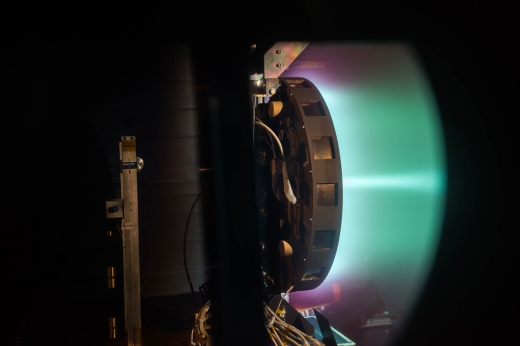
Image: A side shot of the X3 firing at 50 kilowatts. Credit: NASA.
The work at Glenn involved four weeks to set up the thrust stand, mount and connect the thruster with propellant and power supplies, deploying a custom thrust stand to bear the X3’s weight. 25 days of testing then produced the results above in a project funded by NASA’s Next Space Technologies for Exploration Partnership. The next step here will be to integrate the X3 with power supplies now being developed by Aerojet Rocketdyne. By the spring of next year, new tests at NASA Glenn using the Aerojet Rocketdyne power processing system are expected.

Image: The X3 nested-channel Hall thruster with all three channels firing at 30 kW total discharge power. Credit: University of Michigan.
These developments in current Hall thruster technology are exciting in themselves and have implications for the near-term in missions to destinations like Mars. But I’m also interested in pursuing how we might move ion technologies in new directions by creating hybrid designs, with Kuiper Belt objects and the gravitational focus at 550 AU as potential destinations. With laser methods now in the spotlight as Breakthrough Starshot continues its analysis of a mission to Proxima Centauri, hybrid ion engine designs boosted by laser power are coming into consideration. I’ll take a look at the possibilities in tomorrow’s post.

Proxima Centauri Dust Indicates a Complicated System
Just how elaborate is the planetary system around the nearest star? It’s a question rendered more interesting this morning by the news that the ALMA Observatory in Chile has now detected dust in the system in an area one to four times as far from Proxima Centauri as the Earth is from the Sun. Moreover, there are signs of what may be an outer dust belt, an indication that while we have already discovered Proxima Centauri b, we are looking at a system in which cold particles and debris that could have formed other planets continue to accompany the star.

Image: This artist’s impression shows how the newly discovered belts of dust around the closest star to the Solar System, Proxima Centauri, may look. ALMA observations revealed the glow coming from cold dust in a region between one to four times as far from Proxima Centauri as the Earth is from the Sun. The data also hint at the presence of an even cooler outer dust belt and indicate the presence of an elaborate planetary system. These structures are similar to the much larger belts in the Solar System and are also expected to be made from particles of rock and ice that failed to form planets. Note that this sketch is not to scale — to make Proxima b clearly visible it has been shown further from the star and larger than it is in reality. Credit: ESO/M. Kornmesser.
It would surprise no one if Guillem Anglada-Escudé were the lead author of this work, as Anglada-Escudé led the effort that discovered Proxima b. But in this case, the Guillem Anglada who led the dust work, based at the Instituto de Astrofísica de Andalucía, Granada, Spain, simply shares Anglada-Escudé’s name — the two are not related. Further complicating matters is the fact that Proxima b discoverer Anglada-Escudé is a co-author of the paper on dust.
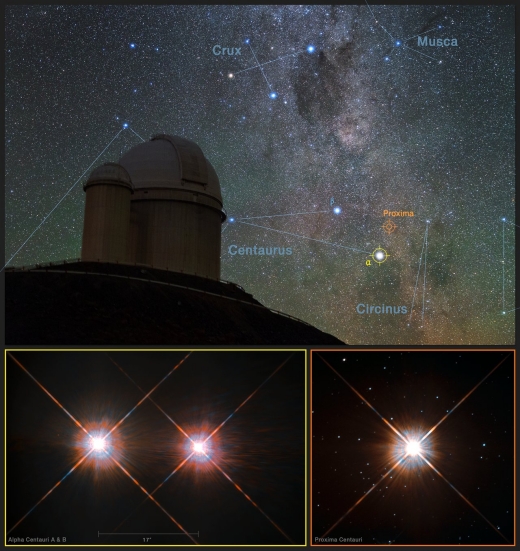
Image: This picture combines a view of the southern skies over the ESO 3.6-metre telescope at the La Silla Observatory in Chile with images of the stars Proxima Centauri (lower-right) and the double star Alpha Centauri AB (lower-left) from the NASA/ESA Hubble Space Telescope. Proxima Centauri is the closest star to the Solar System and is orbited by the planet Proxima b, which was discovered using the HARPS instrument on the ESO 3.6-metre telescope. Credit: Y. Beletsky (LCO)/ESO/ESA/NASA/M. Zamani.
Says lead author Anglada:
“The dust around Proxima is important because, following the discovery of the terrestrial planet Proxima b, it’s the first indication of the presence of an elaborate planetary system, and not just a single planet, around the star closest to our Sun.”
Given Proxima Centauri’s age, at least as old as the Solar System and perhaps older, we’re probably detecting residual dust from regions something like the Kuiper Belt and main asteroid belts in our own system. Such dust can also produce zodiacal light, which can be seen in our own system as sunlight is scattered by interplanetary dust, a faint but observable phenomenon.
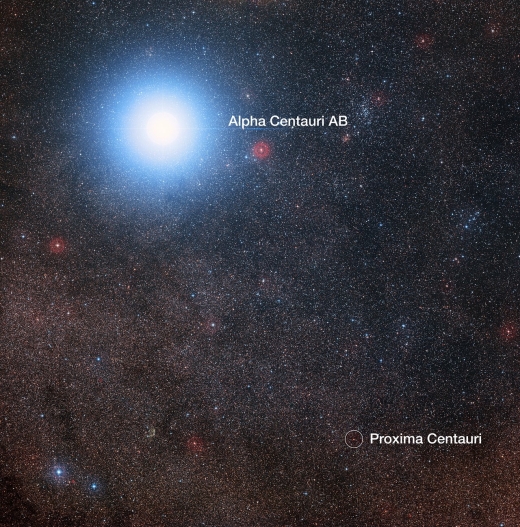
Image: This image of the sky around the bright star Alpha Centauri AB also shows the much fainter red dwarf star, Proxima Centauri, the closest star to the Solar System. The picture was created from pictures forming part of the Digitized Sky Survey 2. The blue halo around Alpha Centauri AB is an artifact of the photographic process, the star is really pale yellow in colour like the Sun. Credit: Digitized Sky Survey 2. Acknowledgement: Davide De Martin/Mahdi Zamani.
The total mass of the inner belt appears to be about 1/100th of Earth’s mass, at a temperature of about -230 degrees Celsius, roughly the temperature in the Solar System’s Kuiper Belt. The inner belt appears to extend a few hundred million kilometres from Proxima Centauri, and could be quite a useful find if it helps us estimate the inclination of the Proxima Centauri system. The dust is assumed to be elliptical given the tilt of what is probably a circular ring around the star. Such a determination would offer us a way to tighten mass estimates of Proxima b.
And are there other planets waiting to be discovered here? Anglada again:
“This result suggests that Proxima Centauri may have a multiple planet system with a rich history of interactions that resulted in the formation of a dust belt. Further study may also provide information that might point to the locations of as yet unidentified additional planets.”
The paper speculates interestingly about a “compact source of 1.3 mm emission at a projected distance of ? 1.2” SE from the star…” which may or may not be an artifact in the equipment, but if real could be anything from a background galaxy (the authors consider this remote) to a Saturn-mass planet with a temperature around 1000 K. The problem: No radial velocity signature of such a planet has yet been found, although if it were there, it should be detectable.
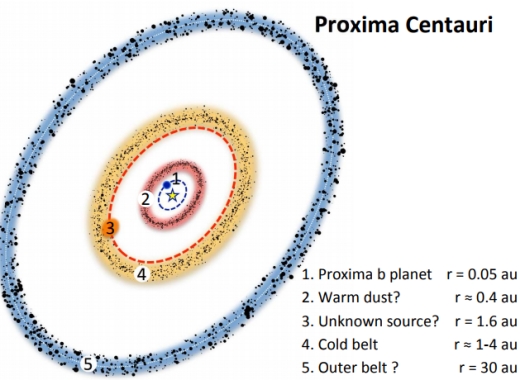
Image: Figure 4 from the paper. Sketch (not to scale) of the proposed components in the Proxima Centauri planetary system. Question marks indicate marginally detected features. Credit: Anglada et al.
The paper is Anglada et al., “ALMA Discovery of Dust Belts Around Proxima Centauri,” accepted at Astrophysical Journal Letters (preprint).

Cold Trap in a Hot Jupiter’s Atmosphere
The other day I looked at how we can use transit spectroscopy to study the atmospheres of exoplanets. Consider this a matter of eclipses, the first occurring when the planet moves in front of its star as seen from Earth. We can measure the size of the planet and also see light from the star as it moves through the planetary atmosphere, giving us information about its composition. The secondary eclipse, when the planet disappears behind the star, is also quite useful. Here, we can study the atmosphere in terms of its thermal variations.
In my recent post, I used a diagram from Sara Seager to show primary and secondary eclipse in relation to a host star. The image below, by Josh Winn, is useful because it drills down into the specifics.
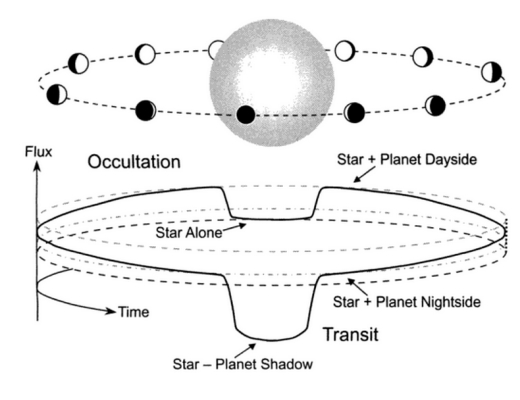
Image: A comparison between transits and secondary eclipses (also sometimes called occultations). In a planetary transit, the planet crosses in front of the star (see lower dip) blocking a fraction of the star’s brightness. In a secondary eclipse, the planet crosses behind the star, blocking the planet’s brightness (see dip in the middle). The latter dip in brightness is fainter due to the faintness of the planet. Credit: Josh Winn. See A New Discovery of a Secondary Eclipse for more background as it applies to the HAT-P-11 system.
Secondary eclipses have been significant in the study of Kepler-13Ab, a world where conditions could not be more different on the planet’s nightside vs. its dayside. A ‘hot Jupiter’ some 1730 light years from Earth, this is a world close enough to its parent star that it is tidally locked. Researchers led by Thomas Beatty (Pennsylvania State) have used the Hubble Space Telescope to determine that that the dayside here can surpass a blistering 3000 Kelvin.
By contrast, the nightside of Kepler-13Ab, turned forever away from the star, is a place where titanium oxide snow can fall. The process is intriguing: Any titanium oxide gas on the star-facing side is carried by strong winds around to the nightside, where the gas condenses into clouds and eventually falls as snow. A gravitational tug six times greater than Jupiter’s pulls the titanium oxide into the lower atmosphere, forming a ‘cold trap’ — an atmospheric layer that is colder than the layers both below and above it. Ascending gases drop back into the trap.
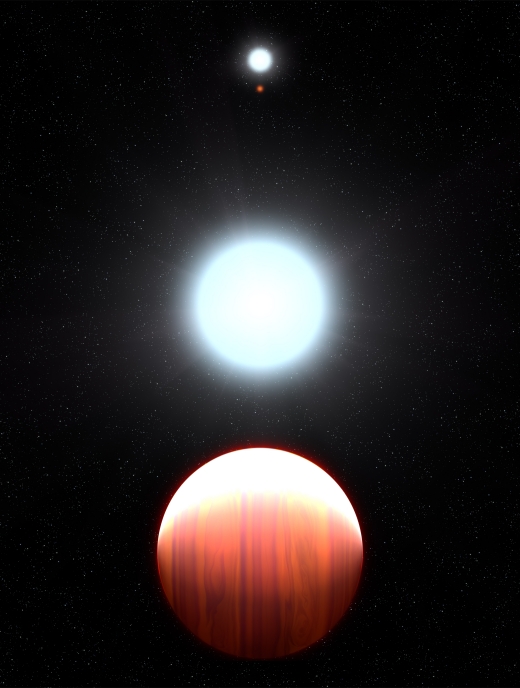
Image: This illustration shows the seething hot planet Kepler-13Ab that circles very close to its host star, Kepler-13A. Seen in the background is the star’s binary companion, Kepler-13B, and the third member of the multiple-star system is the orange dwarf star Kepler-13C. Credit: NASA, ESA, and G. Bacon (STScI).
These Hubble observations are the first time a cold trap has been detected on an exoplanet. The secondary eclipse data reveal that the atmospheric temperature on the dayside actually grows colder with increasing altitude, lacking titanium oxide to absorb light and re-radiate it as heat. Normally, titanium oxide in a hot Jupiter makes the atmosphere warmer at higher altitudes. But larger hot Jupiters possess the characteristics needed for cold traps to form.
From the paper:
We contend that the dual facts that Kepler-13Ab possesses a decreasing temperature-pressure profile and a relatively high surface gravity support the hypothesis of Beatty et al. (2016) that both surface gravity and temperature play a role in determining the presence of a stratospheric temperature inversion in hot Jupiters. Specifically, in high-surface-gravity planets such as Kepler-13Ab, the characteristic freefall time within the atmosphere is substantially shorter (Equation (11)). This should, in turn, substantially increase the efficiency of a day-night (Parmentier et al. 2013) cold-trap process, thereby sequestering the TiO/VO molecules available to cause an inversion in the interior of the planet.
In other words, many of the hot Jupiters we’ve observed likely have precipitation like this, but in those with lower surface gravity than Kepler-13Ab, the titanium oxide snow doesn’t fall far enough to form a cold trap before being drawn back to the dayside of the planet. Note how much information we’re teasing out of secondary transits of a planet we cannot actually see and it should be clear that Beatty is right in referring to the current studies of hot Jupiters as testbeds for how we are going to analyze the atmospheres of terrestrial planets in the future.
The paper is Beatty et al., “Evidence for Atmospheric Cold-trap Processes in the Noninverted Emission Spectrum of Kepler-13Ab Using HST/WFC3,” Astronomical Journal Vol. 154, No. 4 (22 September 2017). Abstract / preprint.

M-dwarf ‘Hot Jupiter’ a Challenge for Planet Formation Theories
The Next Generation Transit Survey has come up with an interesting catch. A gas giant close to the size of Jupiter (about 20 percent less massive) has turned up orbiting a red dwarf some 600 light years away, with an orbital period of 2.6 days. With a temperature calculated at 800 Kelvin, NGTS-1b stands out not because it is a ‘hot Jupiter’ but because stars as small as this one are not normally associated with gas giants. The new planet is, in fact, the largest planet — compared to the size of its companion star — ever discovered.
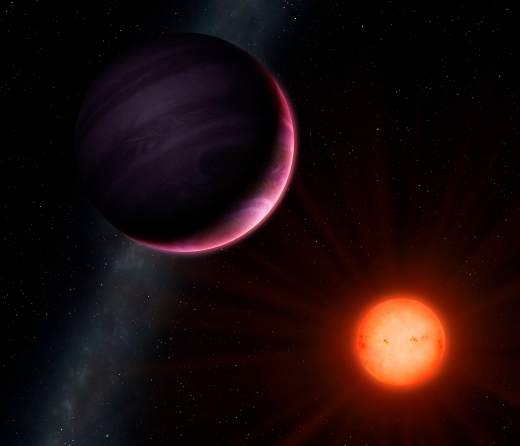
Image: Artist’s impression of planet NGTS-1b with its neighbouring star. Credit: University of Warwick/Mark Garlick.
The Next Generation Planet Survey is a wide-field photometric survey designed to find transiting exoplanets of Neptune-class and smaller around bright stars, using an array of fully-robotic small telescopes operating in the 600-900nm band. The survey is thus sensitive to K and early-M class stars, the goal being to provide targets for instruments ranging from the upcoming European Extremely Large Telescope to the James Webb Space Telescope.
Sited at the European Southern Observatory’s Paranal site in Chile, the survey now has its first catch, about which lead author Daniel Bayliss (Geneva Observatory) comments:
“The discovery of NGTS-1b was a complete surprise to us – such massive planets were not thought to exist around such small stars. This is the first exoplanet we have found with our new NGTS facility and we are already challenging the received wisdom of how planets form.”
We only have three transiting gas giants around M-dwarfs, which are the most common type of star in the galaxy. The two previously discovered planets are Kepler-45b and HATS-6b, the latter a warm transiting ‘Saturn.’ The radius of NGTS-1b has proven tricky to determine because this is a ‘grazing’ transit at the edge of detection — not all of the planet transits the host star’s disc. The authors believe that further data from the upcoming Transiting Exoplanet Survey Satellite will improve their models of the system.
We can hope that surveys like NGTS will eventually monitor enough M-dwarfs to give us statistics on the frequency of hot Jupiters around this class of star — the plan calls for approximately 20000 early-type M-dwarfs per year to be monitored. This will be useful information as we continue to learn about planet formation. We would expect gas giants to be rare around M-dwarfs because protoplanetary disk mass decreases with stellar mass, so there is less material to work with and longer, slower process of planet formation at work.
There is also the question of metallicity, about which we have much to learn. Remember that to an astrophysicist, a metal is any element heavier than helium. The paper comments:
It has long been known that for solar-type host stars the incidence of giant planets increases very sharply with increasing host star metallicity (Fischer & Valenti 2005), and very few giant planets have been detected around stars with significantly sub-solar metallicity. However, the same correlation is not seen for Neptunes or super-Earths, whose incidence appears largely independent of metallicity (Sousa et al. 2008; Buchhave & Latham 2015; Jenkins et al. 2017). By robustly determining the metallicity of NGTS-1 and systems like this we will be able to probe if the correlation between metallicty and giant planet frequency remains true for low mass stars.
The paper is Bayliss et al., “NGTS-1b: A hot Jupiter transiting an M-dwarf,” accepted for publication at Monthly Notices of the Royal Astronomical Society (preprint).

Ambiguity in Life Detection
How likely are we to find a definitive biosignature once we begin analyzing the atmospheres of nearby rocky exoplanets? We have some ideal candidates, after all, with stars like TRAPPIST-1 yielding not one but three potentially life-bearing worlds. The first thing we’ll have to find out is whether any of these planets actually have atmospheres, and what their composition may be.
‘Habitable zone’ is a fluid concept, and that’s not just a reference to liquid water on the surface. A relatively dry terrestrial planet, one with little surface water and not a lot of water vapor in the atmosphere, might avoid a runaway greenhouse and manage to stay habitable in an orbit closer to a G-class star than Earth. A planet with an atmosphere dominated by hydrogen could maintain warm temperatures even at 10 AU and beyond. So we’ll need to find out what any exoplanet atmosphere is made of, and weigh that against its orbital position near its star.

Image: An extended habitable zone that captures some of the more modern thinking about habitable planets. The light blue region depicts the habitable zone for planets with N2-CO2-H2O atmospheres. The yellow region shows the habitable zone as extended inward for dry planets, with little surface water and little water vapor in the atmosphere, as dry as 1% relative humidity. The outer darker blue region shows the outer extension of the habitable zone for hydrogen-rich atmospheres and can extend even out to free-floating planets with no host star. The solar system planets are shown with images. Known exoplanets are shown with symbols [here, planets with a mass or minimum mass less than 10 Earth masses or a radius less than 2.5 Earth radii]. Credit: Image and caption by Sara Seager.
When we use terms like ‘Earth-like’ in relation to atmospheres, we’re talking about nitrogen, oxygen and carbon dioxide, but we also have to remember that atmospheres develop and change over time. The early Earth would have begun with abundant hydrogen and helium, but volcanic eruptions could later supply carbon dioxide, water vapor, sulphur and more. We needed a huge oxygenation event two and a half billion years ago to bring oxygen levels up. Exactly where would an exoplanet be in its development during the time we are able to observe it?
So assume we start examining those interesting transiting worlds around TRAPPIST-1 and find that one of them shows traces of oxygen. Cause for celebration? Certainly, but we’re still a long way from determining whether life is present. Because there are models for oxygen-rich atmospheres that are completely abiotic. TRAPPIST-1 is an M-dwarf, and we know that ultraviolet light from the star can break down carbon dioxide, adding oxygen to the mix.
Water vapor in a planetary atmosphere can likewise be broken down into hydrogen and oxygen through UV radiation, so oxygen by itself is not enough. We saw yesterday that a simultaneous detection of methane would be a much more satisfactory signature. Here we’re looking at two gases that should remove each other from the atmosphere in short order unless there were something there to sustain them. Let me quote Stephen Reinhard (NASA GSFC, and a project scientist on the Transiting Exoplanet Survey Satellite mission) on the matter:
“There are a couple of things we like to see as a potential for habitability — one of them is water, which is probably the single most important, because as far as we know, all life that we’re familiar with depends on water in some way. The other is methane, which on our Earth is produced almost entirely biologically. When you start seeing certain combinations of all of these things appearing together — water, methane, ozone, oxygen — it gives you a hint that the chemistry is out of equilibrium. Naturally, planets tend to be chemically stable. The presence of life throws off this balance.”
Now that sounds pretty straightforward, and surely a simultaneous detection of oxygen and methane would make a strong case for life. But even here, we have to be careful. If there are abiotic sources of oxygen, there are also abiotic sources of methane, even if most of the methane found in our own planet’s atmosphere is associated with living processes. Volcanism is one methane source, and we’ve learned recently that carbon-rich micrometeoroids can produce methane as they burn up upon entry into a planet’s atmosphere.
Systems with larger amounts of dust than our own could conceivably produce a high enough methane signature in a planetary atmosphere to be noted by our space observatories, further complicating the search for life. Here again we’ll have to pay particular attention to the age of the system we’re studying, for systems with dense debris disks are those likely to produce this effect, with planets perhaps undergoing their own version of our Late Heavy Bombardment, when some 3.9 billion years ago our world was pummeled by millions of collisions.
When I said yesterday that it was possible we might get a biosignature detection within as little as ten years, what I was really saying was that we might get some evidence of biology, but very likely it would be ambiguous and hotly contested. Rather than a sudden announcement that life has been found in another star system, the news is likely to emerge as a battle of competing analyses, trying to determine whether what we see could be explained without implicating life.
We also need to pay attention, as Sara Seager and colleagues are doing, to what other gases might be involved in biosignatures. Indeed, life on our planet produces thousands of different gases, most of them in small quantities that accumulate little in the atmosphere. Most are produced for reasons specific to the organism they support, and they do so guided by little more than evolutionary selection. The point here is that life on another world may have surface and atmospheric conditions that produce chemistries profoundly different from Earth’s.
Hence Seager’s interest in studying all the molecules that exist in gas form in a planetary atmosphere in conditions similar to the temperature and pressure of Earth. A recent paper on this work presents results from an examination of 14,000 molecules, about 2500 of which are hydrocarbons, with the goal of eventually producing a truly comprehensive list of biosignature gases and the false positives that accompany them. If there is one thing we can probably state with some confidence, it is that early exoplanet atmospheric studies will produce surprises.
Getting ready for them is what studies like Seager’s are all about. What we’re going to need as we begin to detect ambiguous evidence for biosignatures is a large space telescope well beyond WFIRST in capabilities, one capable of pulling in atmospheric data from enough exoplanets that we can begin to develop a statistical understanding of what we’re seeing. Designs like LUVOIR (Large UV/Optical/Infrared Surveyor) and HabEx (Habitable Exoplanet Imaging Mission) are under study, even as we look beyond them to the kind of mirror technologies that may allow still bigger instruments and more comprehensive analysis.
The Seager paper is Seager, Bains and Petkowski, “Toward a List of Molecules as Potential Biosignature Gases for the Search for Life on Exoplanets and Applications to Terrestrial Biochemistry,” Astrobiology 16(6) (June 201), 465-485 (abstract).

To See a Habitable World
Video presentations from the recent Tennessee Valley Interstellar Workshop are beginning to appear online. It’s welcome news for those of us who believe all conferences should be available this way, and a chance for Centauri Dreams readers to home in on particular presentations of interest. I published my Closing Remarks at TVIW right after the meeting and will watch with interest as the complete 2017 videos now become available. There are a number of these I’d like to see again.
All of this gets me by round-about way to Project Blue, the ongoing attempt to construct a small space telescope capable of directly imaging an Earth-like planet around Centauri A or B, if one is indeed there. For the other talk I gave at TVIW 2017 (not yet online) had to do with biosignatures, and the question of whether we had the capability of detecting one in the near future with the kind of missions now approved and being prepared for launch. This was delivered as part of a presentation and panel discussion with Greg Benford and Angelle Tanner (Mississippi State), one of the conference’s ‘Sagan Meetings.’
The answer is yes, though a highly qualified yes, and Project Blue could be a part of that. When we talk about biosignatures, we are presuming the ability to analyze a planet’s atmosphere, and that is something we’re fully capable of doing today. The fact that such analyses have involved hot gas giants should not deter us, for we’re shaping the methods that will eventually get us down to Earth-mass worlds. These planets won’t necessarily be Earth-like, for the first ones we’ll see in this range will be orbiting red dwarf stars in the immediate neighborhood.
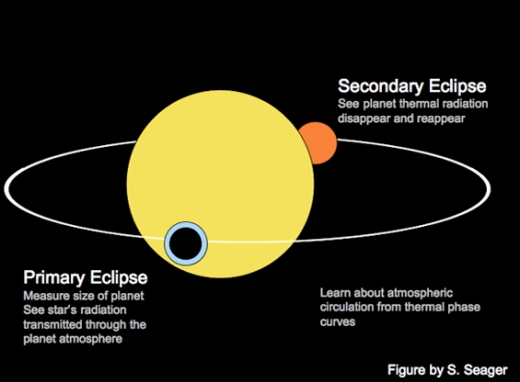
Image: Transmission spectroscopy illustrated. If we can find a transiting world, we can study both the primary eclipse as it moves across the face of the star and the secondary eclipse as the planet’s thermal radiation disappears behind it. Credit: Sara Seager (MIT).
There are reasons for that, most specifically the deep transit depth that an Earth-size planet would present when passing, in a habitable zone orbit, across the face of a nearby red dwarf. In the primary eclipse, some of the starlight we detect has passed through the planet’s atmosphere, giving us the chance to study its components. A biosignature gas is one that is produced by life and accumulates at detectable levels within an atmosphere. We’re especially interested in gases that are out of equilibrium, such as oxygen in the presence of methane.
The point here is that oxygen is unstable over geological timeframes, and would be depleted through reactions with volcanic gases and oxidation unless there existed a source to replace it. A combination of oxygen and methane would indicate a steady source of both, as James Lovelock noted in 1975. The combination is simply out of balance from what would occur through natural processes. Detecting it would indicate the probable presence of life on the planet.
False positive issues abound here, but let’s get into them tomorrow. Because I want to circle back to Project Blue at this point, to discuss the fact that beyond transmission spectroscopy, we have the capability of looking at planets through direct imaging. Coronagraphs are one way of suppressing the light of a central star, and so are starshades, the latter a possibility for the WFIRST mission, which could be constructed so as to be ‘starshade ready’ and thus capable of being joined in space by a later starshade mission that would fly tens of thousands of kilometers away and offer the prospect of detecting planets within 1 AU even of G-class stars like the Sun. In any case, WFIRST is being adapted for a coronagraph whether or not the starshade flies.
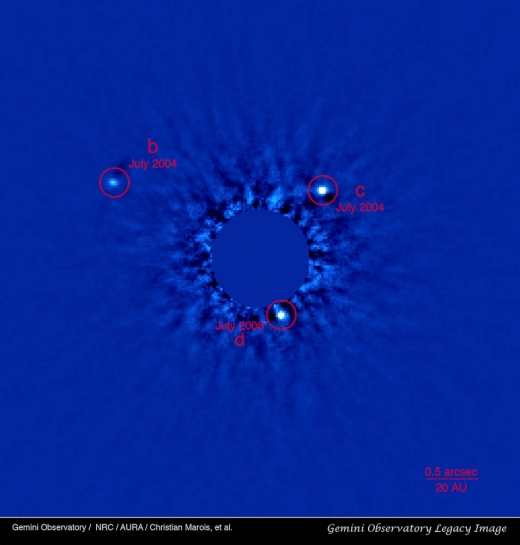
Image: Direct imaging at work. HR 8799 is a star a bit more massive than the Sun, and far younger, about 60 million years old. We see not one but three planets orbiting it. This is the first portrait of an exosolar system. It was announced at the same time as the Fomalhaut candidate, too, giving this system a tie as the first ever seen orbiting a Sun-like star. The planets, labeled b, c, and d, are about 7, 10, and 10 times the mass of Jupiter, respectively, and orbit their star at 68, 38, and 24 times the distance of the Earth from the Sun. It’s possible planets c and d are massive enough to qualify as brown dwarfs. Credit: Gemini Observatory.
I provided the background for Project Blue at the end of September, describing the small telescope originally called ACEsat that, in the hands of Eduardo Bendek and Ruslan Belikov (NASA Ames) later morphed into the crowd-funded Project Blue design. The designers believe that this telescope would be fully capable of photographing a ‘pale blue dot’ around one or both of the primary Alpha Centauri stars, and that would mean we could dispense with transmission spectroscopy and deal with light directly from the planet in question to study its atmosphere.
The Project Blue campaign has a week to run in its attempt to reach a $175,000 goal (it’s 73 percent of the way there as of this morning). Giving the campaign an additional boost is the action of a donor who has pledged to match contributions until the goal is reached, making every dollar people contribute turn into two. Check the project’s Indiegogo page for further information about its light suppression techniques, which include not only a coronagraph but a deformable mirror, low-order wavefront sensors and software control algorithms to manipulate incoming light, as well as post processing methods that substantially enhance image contrast.
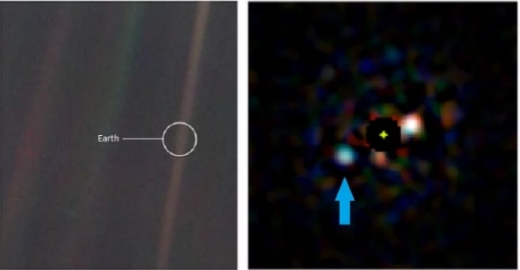
Image: (L) Voyager’s ‘pale blue dot’ photo of Earth from the edge of our Solar System; (R) A simulated image of a photo Project Blue aims to take of exoplanets around one of the stars in the Alpha Centauri system. (Credit: NASA JPL / Jared Males).
Have a look at the Project Blue page and help if you can. The goals involved are to set the science requirements for the mission, complete the opto-mechanical design and request industry letters of interest, while developing a mission performance simulator to analyze different configurations (the latter will eventually become available online).
A mission like Project Blue could conceivably move the timetable forward in terms of biosignature detection, if absolutely everything falls into place and the right kind of planet is indeed orbiting Centauri A or B. Thus, between upcoming red dwarf investigations using the James Webb Space Telescope (aided by data from the Transiting Exoplanet Survey Satellite), and possible direct imaging of an Earth-like planet around the nearest star system, we could conceivably detect biosignatures within the next ten to fifteen years. It’s a stretch, and I’ll explain why tomorrow, but add a decade or two to the timeline and the odds begin to climb.

